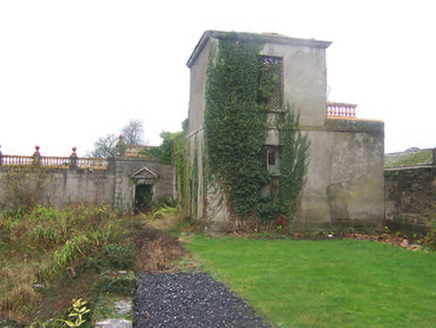Survey Data
Reg No
15400223
Rating
Regional
Categories of Special Interest
Historical, Scientific, Technical
Previous Name
Daramona
Original Use
Laboratory
Date
1880 - 1900
Coordinates
233532, 270934
Date Recorded
01/01/2006
Date Updated
--/--/--
Description
Single-bay two-storey former observatory, built c.1892, with attached single-storey building to the west, formerly a laboratory, darkroom and machine shop. Now ruinous and out of use. Dome to observatory now removed, flat roof to former laboratory with remains of balustraded parapet over. Cement rendered walls over plinth with projecting rendered string course at first floor level. Square-headed openings with remains of two-over-two pane timber sliding sash windows to ground floor, window/openings above now missing. Set back from road in grounds of and adjacent to Daramona House (14500208).
Appraisal
A modest and ruinous late nineteenth-century observatory, which is of huge importance in the history of astronomy. It was built by William E. Wilson (1851-1908), an astronomer of international repute. The present observatory replaced an earlier one, built c.1871, which was located to the west of the present site. William Wilson and others carried out a series of important works here in the late nineteenth and early-twentieth centuries, which included the first accurate measurements of the temperature of the sun (with P. L. Gray), the first cinematographic photographs of a sun spot, a series of unrivalled photographs of nebulae and star clusters, early experiments on X-rays and important work on the photoelectric detection of starlight along with Professor Minchin (London) and Professor George Francis Fitzgerald (TCD). Wilsons’ nephew, Kenneth Edgeworth (1880-1972), was born at Daramona House and lived there for a few years; after a distinguished military career he carried out important theoretical research on the Solar System. Edgeworth speculated in 1943 that there is a belt of cometary material beyond the orbit of Neptune. Since 1992 thousands if bodies have been found in the Edgeworth-Kuiper belt, and these are now the subject of intense research. Other distinguished visitors to Daramona included Professor A.A. Rambaut, Professor C.V. Boys and Sir Howard Grubb. In 1922 the Wilson Family moved to England and donated the original 24 inch Grubb Telescope to the University of London, where a new observatory was built to house it, and much of the original instrumentation to Trinity College, Dublin. The telescope has been housed at the Merseyside County Museum in Liverpool since 1974. Daramona Observatory, despite its currently dilapidated condition, is an extremely important site in historical and scientific terms and is an unusual addition to the built heritage of Westmeath.

